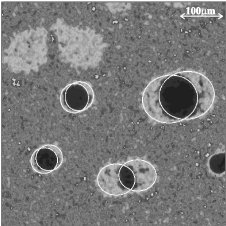In-flight particle size and shape analysis
T. V. Streibl, et al., from the Universität der Bundeswehr in Munich is using the 4 Picos ICCD camera for in-flight particle size analysis and particle shape measurements of thermal spray coating processes.

Particle size defines the quality of thermal spray coating
The thermal spray coating involves heating a material to a molten or semi-molten state. The material is propelled using a heat source, e.g. a plasma jet, creating a surface structure on a given substrate. The process is very complex because it depends on numerous parameters influencing each other. The in-flight particle properties like particle size and shape are important to improve the process efficiency and quality.
Particle size analysis using the particle shape imaging technique
The particle shape imaging technique offers high potential in particle size diagnostics. It is intended for the analysis of the particle size and the shape of the particles within the plasma jet. The method is based on microscopic imaging of the
particle shades. A cw-laser beam is split into two beams of equal intensities, which are superimposed in the focal plane of a long-distance-micorscope. Two individual shades are generated by a passing particle. The separation of these shades is
a measure of the distance of the particle to the focal plane of the microscope. The particle size and shape can be directly determine on the area and contour of the shades. A schematic view of the experimental setup is shows the Figure above.


High speed photography for sharp images of the particles
The short exposure time of 5ns is necessary for sharp imaging since the particles are moving with velocities up to 500m/s. The interference rings and noise effects of the raw image (left figure) can eliminated by subtracting a background image without particles. Threshold values are used for discriminating the full from the partial shaded regions. The contours are approximated by ellipses. For particle size analysis two ellipses of a single particle must have identical form and orientation. The distance between the centres of two ellipses enables calculation of the particles distance from the focal plane. The particle size can be directly measured on the size of the shades which belong to the same particle.
Successful demonstration in-flight particle size analysis
The 4 Picos ICCD camera is used by T. V. Streibl, et al., for in-flight particle size analysis within the plasma jet of a thermal spray coating device. The camera provides necessary short exposure times to get meaningful images in combination with
high spatial resolution. In combination with the trigger system these measurements provide velocity information in combination with the size and shape of the particles.
Title: Diagnostics of thermal spray processes by in-flight measurement of particle
size and shape with innovative Particle-Shape-Imaging (PSI) technique
Author: Tilo V. Streibl, Thomas Duda, and Klaus D. Landes
Institute: Universität der Bundeswehr, Munich, Germany
